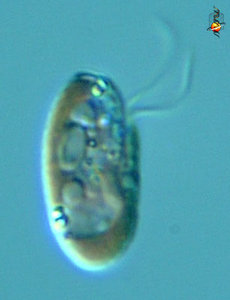Proteomonas sulcata
Kerstin Hoef-Emden and John M. ArchibaldIntroduction
Described by Hill and Wetherbee; type species Proteomonas sulcata (marine; Hill and Wetherbee 1986).
Only one strain has been sequenced (Marin et al. 1998; Deane et al. 2002; Hoef-Emden et al. 2002). Proteomonas sulcata was the first cryptophyte for which a dimorphism was reported (Hill and Wetherbee 1986). In molecular phylogenies inferred from nucleomorph SSU rDNA sequences, this strain seems to be related to the other two PE545-containing clades with free nucleomorphs (Guillardia/Hanusia and Geminigera/Plagioselmis/Teleaulax genus complex), whereas its position is not resolved in nuclear SSU rDNA phylogenies (Hoef-Emden et al. 2002).
Characteristics
- Type of biliprotein: PE545
- Nucleomorph free in periplastidial space
- Dimorphic
- Light microscopy: reddish cryptophytes, one bilobed plastid with a pyrenoid, haplomorphs smaller than diplomorphs
- Ultrastructure of haplomorph: inner periplast component with hexagonal plates, surface covered by hexagonal scales, furrow only, non-keeled rhizostyle
- Ultrastructure of diplomorph: sheet-like inner periplast component, surface covered by fibrils and rosulate scales, furrow only, keeled rhizostyle
References
Deane JA, Hill DRA, Brett SJ, McFadden GI (2002) Cryptomonad evolution: Nuclear 18S rDNA phylogeny versus cell morphology and pigmentation. J. Phycol. 38: 1236-1244
Hill DRA, Wetherbee R (1986) Proteomonas sulcata gen. et sp. nov. (Cryptophyceae), a cryptomonad with two morphologically distinct and alternating forms. Phycologia 25: 521-543
Hoef-Emden K, Marin B, Melkonian M (2002) Nuclear and nucleomorph SSU rDNA phylogeny in the Cryptophyta and the evolution of cryptophyte diversity. J. Mol. Evol. 55: 161-179
Marin B, Klingberg M, Melkonian M (1998) Phylogenetic relationships among the Cryptophyta: analyses of nuclear-encoded SSU rRNA sequences support the monophyly of extant plastid-containing lineages. Protist 149: 265-276
Title Illustrations

| Scientific Name | Proteomonas sulcata |
|---|---|
| Location | material from Provasoli-Guillard National Center for Culture of Marine Phytoplankton |
| Source | Proteomonas sulcata |
| Source Collection | Micro*scope |
| Image Use |
 This media file is licensed under the Creative Commons Attribution-NonCommercial-ShareAlike License - Version 2.5. This media file is licensed under the Creative Commons Attribution-NonCommercial-ShareAlike License - Version 2.5.
|
| Copyright | © Bob Andersen and D. J. Patterson |
About This Page
This page is being developed as part of the Tree of Life Web Project Protist Diversity Workshop, co-sponsored by the Canadian Institute for Advanced Research (CIFAR) program in Integrated Microbial Biodiversity and the Tula Foundation.
Kerstin Hoef-Emden

Universität zu Köln, Köln, Germany
John M. Archibald

Dalhousie University, Halifax, Nova Scotia, Canada
Correspondence regarding this page should be directed to Kerstin Hoef-Emden at and John M. Archibald at
Page copyright © 2010 Kerstin Hoef-Emden and John M. Archibald
 Page: Tree of Life
Proteomonas sulcata.
Authored by
Kerstin Hoef-Emden and John M. Archibald.
The TEXT of this page is licensed under the
Creative Commons Attribution-NonCommercial License - Version 3.0. Note that images and other media
featured on this page are each governed by their own license, and they may or may not be available
for reuse. Click on an image or a media link to access the media data window, which provides the
relevant licensing information. For the general terms and conditions of ToL material reuse and
redistribution, please see the Tree of Life Copyright
Policies.
Page: Tree of Life
Proteomonas sulcata.
Authored by
Kerstin Hoef-Emden and John M. Archibald.
The TEXT of this page is licensed under the
Creative Commons Attribution-NonCommercial License - Version 3.0. Note that images and other media
featured on this page are each governed by their own license, and they may or may not be available
for reuse. Click on an image or a media link to access the media data window, which provides the
relevant licensing information. For the general terms and conditions of ToL material reuse and
redistribution, please see the Tree of Life Copyright
Policies.
- First online 14 September 2008
- Content changed 14 September 2008
Citing this page:
Hoef-Emden, Kerstin and John M. Archibald. 2008. Proteomonas sulcata. Version 14 September 2008 (under construction). http://tolweb.org/Proteomonas_sulcata/128543/2008.09.14 in The Tree of Life Web Project, http://tolweb.org/








 Go to quick links
Go to quick search
Go to navigation for this section of the ToL site
Go to detailed links for the ToL site
Go to quick links
Go to quick search
Go to navigation for this section of the ToL site
Go to detailed links for the ToL site